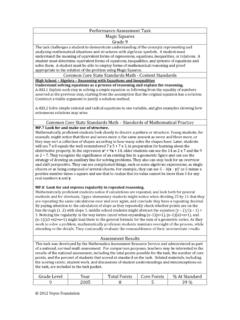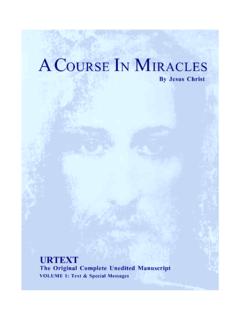Transcription of The Advantages and Disadvantages of Using a Coursebook
1 1 The Advantages and Disadvantages of Using a Coursebook Introduction The coursbook dilemma has long provided subject for debate in ELT, no less so today with the plethora of interactive web-tools available to trainers and the emergence of self-published materials, not to mention the current interest in the dogme approach. This paper seeks to outline the Advantages and Disadvantages of Using a Coursebook , with particular focus on English for Specific Purposes (ESP), before going on to consider a possible model for future language learning delivery. Literature review In the 90 s Hutchinson and Torres (1994) suggested that Coursebooks survive .. primarily because they are the most convenient means of providing the structure the teaching-learning system.
2 Requires. while Bell and Gower (1998) commented that the language presented in many coursebooks bears little relationship to real language use and more to Coursebook convention. During this period there was much criticism of the lack of authenticity in coursebooks, in particular the use of over-simplified texts specially contrived for language teaching purposes MacWilliam (1986). Wajnryb (1996) went so far as to imply that through the sanitised and PG-rated world promoted in coursebooks trainers were actually de-socialising their learners. More recently Tomlinson (2010) argued that textbooks were designed primarily to satisfy administrators and teachers but in doing so often ignore the needs and wants of learners.
3 Conversely, in 2012 he concludes that awareness of what constitutes effective, principled materials grounded in SLA research has progressed dramatically as has their production. However, as the debate continues the numbers still relying on coursebooks is worthy of note. In 2008 the British Council found 65% of their trainers used a Coursebook on a regular basis, and Tomlinson, surveying conference attendees in Asia and the UK in 2010, noted that 92% regularly used a Coursebook . Advantages Advocates of the Coursebook cite the need for structure, predominantly in terms of language presentation for both trainer and learner. This is even more pertinent when teaching ESP, as the content element provides an additional burden to trainers.
4 Teaching in-work learners may result in an expert-non expert collaborative approach, but, pre-experience learners often require more guidance regarding concepts in the given field. Coursebooks produced in Europe are usually set against the Common European Framework which is one way of responding to the requirements of the stakeholder (often company training manager) providing course credibility and accountability as well as a certain degree of consistency and quality control. Coursebooks provide a time-efficient and cost-effective means of delivery for stakeholder and trainer alike. Few ESP trainers are granted adequate time for class preparation. This, coupled with the number of courses and the range of disciplines taught leaves little time for course design.
5 Most commercially produced courses include audio-visual and digital components. The variety of medium helps to increase learner motivation. In addition, they expose learners to the visual (gesture, facial expression, proxemics) and auditory (ellipsis, redundancy, overlapping speech) features of the language as well as provide the necessary environmental and physical clues to help learners understand usage and register in a particular context, thus assisting their development of effective spoken communication. 2 Experts will have more confidence in and respect for a teacher who has a grasp of the relevant concepts . (Dudley Evans, 2005) Hailing traditionally from a humanities background, many trainers lack knowledge of the financial, scientific or engineering sectors in which their learners work.
6 It is vital therefore that the ESP Coursebook supports the trainer, not only in terms of lexis and pragmatics, but also content-wise as a basic reference on which to base the course (Estaban, 2002). Teachers guides represent an equally important means of support in particular for ESP trainers, provided they include, according to Crawford (2002), adequate information about the materials provided, and clear and theoretically explicit rationales for the activities proposed . Finally, few CELTA-trained teachers possess the necessary skills for developing principled materials based on SLA research. Estaban (idem) goes so far as to suggest that tailoring ESP materials is a major risk for those not expert in materials production.
7 Fewer still, are those qualified in teaching, the specialisation concerned and materials development. However, while far from systematic, there has recently been a move towards a more principled approach to the design of ESP coursebooks. Many such coursebooks* have been written in collaboration with, or at least have been reviewed by, a renowned expert from the field. Disadvantages Of the major criticisms of published coursebooks, the use of inauthentic language and the inability to respond adequately to the real needs of the learner are possibly the most pertinent, and are particularly relevant to ESP. Nelson (2003), comparing a corpus of spoken and written business situations, with one compiled from 33 Business English coursebooks confirmed a mismatch.
8 Typically, he found that interactions were over-polite, insufficiently vague and invariably comprised of adjacency pairs. Language was transactional and functional with a high concentration of nouns over action verbs. Authentic texts, where present, simply talked about business (interviews with CEOs) instead of getting on and doing it . However, a revolution in published ESP materials over the last five years has resulted in the increased inclusion of authentic texts, both written and spoken. Authentic materials and use of corpora, such as the CANBEC, can provide meaningful exposure to language as it is actually used in the workplace. They serve to increase learners understanding of aspects of the language so dependent on context and thus help develop a range of communicative competencies.
9 In addition, authentic materials motivate learners and enhance positive attitudes towards the learning of a language, allowing for increased personalisation. By incorporating authentic texts, publishers are finally attempting to facilitate the learner s transition into the professional environment as opposed to making it up as they go along (Nelson). Ultimately, professionals need to gain maximum exposure not only to texts that are authentic to them, but also to tasks that are for the most part representative of those they are required to carry out in English around such texts; therefore achieving an outcome as opposed simply to linguistic accuracy.
10 The ESP revolution has resulted in some publishers producing coursebooks that seek to replicate real-world tasks and methodology from the field*. In doing so, these coursebooks not only more closely reflect the working environment of the target audience, but also provide greater opportunities for learners to draw on their own (professional) experience. Learners are able to concentrate on language usage and both learner and stakeholder grasp their immediate relevance and credibility. 3 The constraints of the commercial publisher will always be an issue and go some way towards explaining the reason behind much of the criticism directed specifically at ESP coursebooks. Relatively speaking production costs for niche-market coursebooks, coupled with poor adoption levels means that return on investment remains modest, with publishers preferring to invest in more profitable (secondary or general English) courses.







